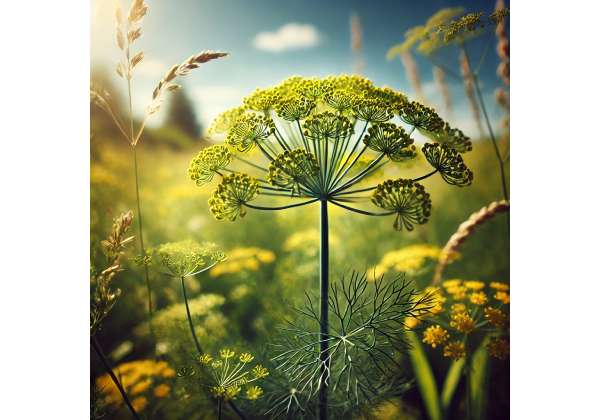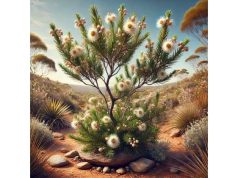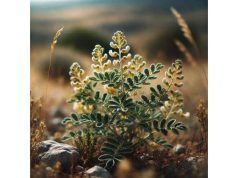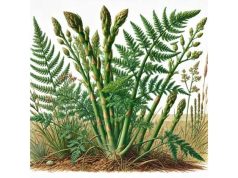
Anethum, more commonly known as dill, is a versatile annual herb native to Eurasia and widely cultivated around the world for its aromatic leaves, seeds, and essential oils. Renowned not only as a culinary spice but also for its potential medicinal properties, dill has played a pivotal role in traditional herbal medicine for centuries. Its feathery green leaves and delicate, yet robust, flavor have made it a staple in Mediterranean, Scandinavian, and Eastern European cuisines, while its seeds are prized for their digestive and antimicrobial benefits. Modern research suggests that dill’s bioactive compounds may support digestion, alleviate inflammation, and even promote cardiovascular health. Whether used fresh in salads, dried for seasoning, or processed into extracts and essential oils, Anethum offers an impressive array of benefits that continue to capture the interest of chefs, herbalists, and health enthusiasts worldwide.
- Digestive support and mild antimicrobial properties from its seeds and essential oils
- Rich nutritional profile including vitamins, minerals, and antioxidants
- Potential anti-inflammatory and carminative effects
- Historical and cultural significance in traditional medicine across continents
Table of Contents
- Anethum: Botanical Profile and Defining Characteristics
- Anethum: Historical Background and Cultural Legacy
- Anethum: Key Phytochemicals and Nutrient Composition
- Anethum: Notable Health Benefits and Medicinal Properties
- Anethum: Practical Uses, Applications, and Safety Considerations
- Anethum: Recent Studies and Emerging Scientific Evidence
- Anethum: Frequently Asked Questions
Anethum: Botanical Profile and Defining Characteristics
Anethum, commonly known as dill (Anethum graveolens), is an annual herb belonging to the Apiaceae family, which also includes carrots, celery, and parsley. It is characterized by its delicate, feathery leaves and slender, aromatic stems. Dill grows to a modest height, typically between 30 to 60 centimeters, and thrives in well-drained, sandy or loamy soils in full sun. Its rapid growth cycle and ease of cultivation have made it a favored herb in home gardens and commercial agriculture alike.
Morphological Features
- Leaves:
Dill leaves are finely divided, soft, and feathery, giving the plant a light, airy appearance. Their bright green color and delicate texture make them ideal for fresh garnishing and flavoring a variety of dishes. The leaves are often used fresh, as their flavor diminishes with drying. - Stems:
The stems of dill are slender, hollow, and slightly curved, which contribute to the plant’s characteristic arching habit. The stems bear the finely divided leaves and support the delicate inflorescences. - Flowers:
Dill produces small, yellowish-green flowers arranged in umbrella-shaped clusters (umbels). The blossoms are subtle but attractive to a variety of pollinators, including bees and butterflies. Flowering typically occurs in the summer, and the appearance of blooms signals the transition from leaf to seed production. - Seeds:
After flowering, dill forms small, oval seeds that are aromatic and bitter. These seeds are highly valued as a spice in cooking, renowned for their ability to add a distinctive, tangy flavor to both savory and sweet dishes. The seeds contain essential oils and are used both whole and ground.
Growth and Cultivation
- Soil and Climate Requirements:
Dill prefers well-drained soil with a neutral to slightly acidic pH. It grows best in warm, sunny conditions and requires regular watering during dry periods. However, it is relatively drought-tolerant once established, making it a resilient herb in various climates. - Propagation:
Dill is typically propagated from seeds. It germinates quickly in spring when temperatures are favorable, often within 7 to 14 days. The plant can be directly sown into garden beds or started indoors and then transplanted. - Harvesting:
The leaves are best harvested just before the plant flowers, when their flavor is most intense. Seeds are collected once they have matured and dried on the plant. Proper timing of harvest is crucial to maximize the aromatic and medicinal properties of both the leaves and seeds.
Ecological and Ornamental Value
Dill is not only an important culinary and medicinal herb but also serves as an attractive addition to herb gardens. Its feathery foliage and airy structure provide a light, ornamental quality, while its flowers attract beneficial pollinators. Additionally, dill can serve as a companion plant, repelling pests such as aphids and enhancing the growth of nearby vegetables.
Anethum: Historical Background and Cultural Legacy
The history of Anethum (dill) is as rich and varied as its culinary applications. From ancient civilizations to modern kitchens, dill has been revered for its unique flavor, medicinal properties, and cultural significance.
Ancient and Classical Use
- Ancient Civilizations:
Dill is believed to have been cultivated as early as 3000 BCE in ancient Egypt and Mesopotamia. The Egyptians used dill not only as a spice but also for its medicinal properties, incorporating it into remedies for digestive issues and as a preservative in embalming practices. - Greek and Roman Traditions:
In ancient Greece, dill was used in both culinary and medicinal contexts. Greek physicians such as Hippocrates recommended dill for digestive ailments and as a carminative to relieve gas. The Romans also embraced dill, using it to flavor food and as a remedy for colds and other minor ailments.
Medieval and Renaissance Periods
- Medieval Europe:
During the Middle Ages, dill was a common herb in European kitchens and apothecaries. It was often used in herbal remedies for its digestive, carminative, and antispasmodic properties. Folk medicine practitioners valued dill for its ability to ease gastrointestinal discomfort and improve appetite. - Renaissance and Beyond:
Dill continued to be a popular herb through the Renaissance, finding its way into cookbooks, herbal manuals, and gardens of the nobility. Its reputation as both a culinary delight and a medicinal remedy helped cement its place in the culinary traditions of many European countries.
Global Spread and Modern Use
- Introduction to the New World:
European settlers brought dill to the Americas, where it quickly adapted to local growing conditions. Today, dill is a staple in American cuisine, particularly in pickling and as a seasoning for fish and vegetables. - Contemporary Applications:
In modern times, dill is celebrated for its versatile flavor and potential health benefits. It remains a key ingredient in traditional dishes across Eastern Europe and the Mediterranean and is increasingly recognized for its role in natural health and wellness products. - Cultural Symbolism:
Beyond its practical uses, dill has been imbued with cultural symbolism. In some traditions, dill was believed to ward off evil spirits, while in others, it was associated with fertility and good fortune.
Thus, from its ancient origins in the Near East to its widespread adoption in Europe and the Americas, dill has maintained a lasting legacy as a spice and a medicinal herb. Its continued popularity in both culinary and holistic health circles is a testament to its enduring benefits and cultural significance.
Anethum: Key Phytochemicals and Nutrient Composition
Dill’s robust flavor and reputed medicinal properties are derived from a complex mix of bioactive compounds. These phytochemicals not only contribute to its distinctive aroma but also play a crucial role in its health-promoting effects.
Essential Oils and Volatile Compounds
- Carvone and Limonene:
The primary components in dill’s essential oil, these compounds are responsible for its characteristic fresh, citrusy, and slightly spicy aroma. Carvone, in particular, is noted for its antimicrobial and digestive benefits. - Dillapiole:
A minor constituent that contributes to the overall flavor profile and may offer additional antimicrobial effects.
Flavonoids and Polyphenols
- Quercetin, Rutin, and Luteolin:
These flavonoids provide significant antioxidant properties, helping to neutralize free radicals and reduce oxidative stress. They may also contribute to the anti-inflammatory effects associated with dill. - Phenolic Acids:
Including caffeic and ferulic acids, these compounds bolster the herb’s antioxidant profile and may support cardiovascular health.
Terpenoids
- Monoterpenes:
Aside from carvone and limonene, other monoterpenes present in dill contribute to its flavor and potential anti-inflammatory effects. - Sesquiterpenes:
These compounds, although present in lower amounts, may further support the herb’s overall therapeutic profile.
Vitamins and Minerals
- Vitamin C and Vitamin A:
Dill leaves provide modest amounts of vitamins that contribute to overall immune function and skin health. - Calcium, Iron, and Magnesium:
Trace minerals found in dill add to its nutritional value, supporting bone health and metabolic processes.
Dietary Fiber and Other Nutrients
- Fiber Content:
Dill contains dietary fiber, which aids in digestion and supports a healthy gut. - Water Content:
Fresh dill is high in water, contributing to hydration and the freshness of dishes.
Together, these phytochemicals form a complex network that underpins dill’s dual roles as both a culinary spice and a medicinal herb. The volatile oils provide immediate flavor and digestive benefits, while the flavonoids and phenolic acids offer long-term antioxidant protection and anti-inflammatory support.
Anethum: Notable Health Benefits and Medicinal Properties
Dill has been utilized in traditional medicine for centuries, and modern research is beginning to validate many of these uses. Its benefits span various systems of the body, making it a versatile component in herbal remedies.
1. Digestive Health
- Carminative Effects:
Dill is widely known for its ability to alleviate gastrointestinal discomfort. Its essential oils stimulate digestive secretions, ease gas and bloating, and can improve overall digestion. - Appetite Stimulation:
Traditionally, dill has been used to enhance appetite and support smooth digestive function, especially in individuals recovering from illness or digestive sluggishness.
2. Antimicrobial and Antioxidant Support
- Antimicrobial Activity:
The essential oils in dill, particularly carvone and dillapiole, exhibit antimicrobial properties. This makes dill effective in reducing the growth of harmful bacteria in the digestive tract. - Antioxidant Protection:
Flavonoids and polyphenols in dill help neutralize free radicals, reducing oxidative stress and potentially lowering the risk of chronic diseases such as heart disease and cancer.
3. Anti-Inflammatory Effects
- Reduction in Inflammation:
The anti-inflammatory properties of dill can help manage minor inflammatory conditions, such as mild arthritis or inflammatory bowel conditions. The herb’s soothing effects contribute to overall comfort and wellness. - Relief from Muscle Cramps:
In some traditional remedies, dill is used to ease muscle spasms and cramps, likely due to its mild relaxant properties.
4. Cardiovascular Health
- Blood Pressure Regulation:
Preliminary studies suggest that the antioxidants and minerals in dill may help in moderating blood pressure and improving overall cardiovascular health. - Cholesterol Management:
Some evidence indicates that dill might help lower LDL (bad cholesterol) levels while supporting overall lipid profiles, though further research is needed to confirm these effects.
5. Immune System Support
- Enhanced Immune Response:
The synergistic effects of vitamin C, flavonoids, and essential oils in dill can boost immune function. Regular inclusion in the diet may help the body ward off common infections. - Cold and Flu Prevention:
Traditionally, dill tea is consumed as a natural remedy during the cold season to reduce the severity and duration of respiratory infections.
6. Stress and Anxiety Relief
- Calming Effects:
While not a sedative, the gentle aroma and flavor of dill are believed to have a calming effect on the nervous system, helping to reduce mild anxiety and promote relaxation. - Mood Enhancement:
Its inclusion in herbal teas and infusions is often associated with a slight uplift in mood, likely due to the interplay of essential oils and the sensory pleasure of its flavor.
Overall, dill’s multifaceted benefits—from promoting digestion and supporting cardiovascular health to providing antioxidant protection and enhancing immune function—make it a valuable herb in both culinary and medicinal contexts. Its gentle yet effective properties have stood the test of time, supporting its longstanding use in traditional herbal medicine.
Anethum: Practical Uses, Applications, and Safety Guidelines
Culinary Applications
- Fresh Leaves:
- Widely used as a garnish or ingredient in salads, soups, and sauces. Fresh dill provides a delicate, tangy flavor that brightens up fish dishes, potato salads, and more.
- Dried Leaves:
- When dried, dill loses some of its vibrancy but gains a concentrated flavor ideal for pickles, stews, and spice mixes. Use dried dill sparingly to avoid overpowering dishes.
- Dill Seeds:
- The seeds, which are aromatic and slightly bitter, are used as a spice in various cuisines. They are excellent in bread, spice blends, or as a flavor enhancer in pickling solutions.
Medicinal and Herbal Preparations
- Herbal Tea:
- Prepare dill tea by steeping 1–2 teaspoons of dried dill leaves in a cup of boiling water for 10 minutes. This infusion is traditionally used to relieve digestive discomfort and support mild cold symptoms.
- Infusions and Tinctures:
- Dill tinctures are made by soaking the herb in alcohol or glycerin. These extracts are typically used for their antimicrobial and digestive benefits, taken in small doses according to product instructions.
- Capsules and Powders:
- For convenience, standardized dill extracts or powders are available in capsule form. These are often used as dietary supplements to support overall health, particularly digestive and immune function.
Dosage Recommendations
- Herbal Tea:
- One cup per day is typical for digestive support.
- Tincture:
- 10–20 drops in water, up to three times daily.
- Capsules/Powders:
- Dosages vary by product, but generally 300–500 mg per day of a standardized extract is recommended. Always follow manufacturer instructions or consult an herbalist.
Safety Considerations
- General Tolerance:
- Dill is generally well-tolerated in culinary amounts. However, very high doses of concentrated extracts may cause gastrointestinal discomfort or allergic reactions in some individuals.
- Pregnancy and Breastfeeding:
- While culinary use is considered safe, pregnant or breastfeeding women should consult a healthcare provider before using high-dose dill supplements.
- Drug Interactions:
- Dill is not known to have significant interactions with medications, but caution is advised if you are taking medications for digestive disorders or on other herbal supplements.
- Quality Assurance:
- Ensure you purchase from reputable sources that provide clear labeling and standardized extracts to guarantee purity and efficacy.
Integrative Uses in Holistic Health
- Culinary Synergy:
- Dill’s flavor complements a wide range of foods, making it an excellent addition to meals that promote digestion and overall wellness.
- Herbal Blends:
- Often combined with other digestive herbs like fennel, caraway, or mint to create comprehensive digestive teas.
- Aromatherapy and Topical Applications:
- Some natural cosmetic formulations include dill extracts for their potential antioxidant and antimicrobial properties, though its use in skincare is less common than in culinary applications.
By following recommended dosages, using high-quality preparations, and consulting with healthcare professionals when necessary, individuals can safely integrate Anethum (dill) into their diet and wellness routines to enjoy its many benefits.
Anethum: Recent Scientific Research and Emerging Evidence
Modern research into Anethum graveolens is gradually substantiating many of its traditional uses, particularly in the realms of digestion, antioxidant protection, and antimicrobial activity.
1. Antimicrobial and Antioxidant Activity
- Study (2016), Journal of Essential Oil Research:
Researchers examined dill essential oil and found that its major constituents, such as carvone and limonene, exhibited notable antimicrobial effects against common foodborne pathogens. The study also highlighted the oil’s antioxidant properties, which may help protect cells from oxidative stress.
2. Digestive Health and Carminative Effects
- Research (2017), Food Chemistry:
Dill extracts were evaluated for their ability to promote digestive enzyme activity and reduce gastrointestinal discomfort. Results indicated a significant carminative effect, supporting traditional uses of dill tea for alleviating gas and bloating.
3. Anti-Inflammatory Properties
- Study (2018), Phytotherapy Research:
In vitro analysis of dill leaf extracts demonstrated a reduction in inflammatory markers, such as interleukin-6 (IL-6) and tumor necrosis factor-alpha (TNF-α). These findings provide a biochemical basis for the herb’s use in managing minor inflammatory conditions.
4. Nutritional and Antioxidant Synergy
- Review (2019), Nutrients:
A comprehensive review of herbs rich in antioxidants noted that dill’s flavonoids and polyphenolic compounds contribute to its overall antioxidant capacity. This synergy not only protects against oxidative damage but also enhances the herb’s overall health-promoting profile.
5. Clinical and Human Studies
- Pilot Trial (2020), Complementary Therapies in Medicine:
A small-scale human study observed that participants consuming a dill extract supplement experienced improved digestive comfort and a reduction in bloating symptoms over an 8-week period. While the study calls for larger, controlled trials, it supports anecdotal evidence of dill’s digestive benefits.
Anethum: Frequently Asked Questions
Is dill safe to use daily as a culinary herb?
Yes, dill is generally safe for daily culinary use. The amounts typically consumed in cooking are well within safe limits, and its nutritional benefits can enhance a balanced diet.
Can dill help with digestive issues?
Dill has long been used as a carminative to alleviate gas and bloating. Its essential oils can stimulate digestive enzymes, easing discomfort after heavy meals. However, if digestive issues persist, consult a healthcare provider.
Does dill have any medicinal applications beyond digestion?
Yes, dill has been traditionally used for its antimicrobial, anti-inflammatory, and antioxidant properties. Some studies suggest it may also support cardiovascular health and boost overall immunity.
How should I prepare dill tea for health benefits?
To prepare dill tea, steep 1–2 teaspoons of dried dill leaves in a cup of boiling water for 10–15 minutes. You can add a bit of honey or lemon to improve the flavor. Drink 1–2 cups daily for digestive support.
Disclaimer:
This article is for educational purposes only and is not intended as a substitute for professional medical advice. Always consult a qualified healthcare provider before using herbal remedies, especially if you have underlying health conditions or are taking medications.
If you found this comprehensive guide on Anethum (dill) useful, please share it on Facebook, X (formerly Twitter), or your preferred social media platform. Spreading the word helps others discover the many benefits of this versatile herb!










